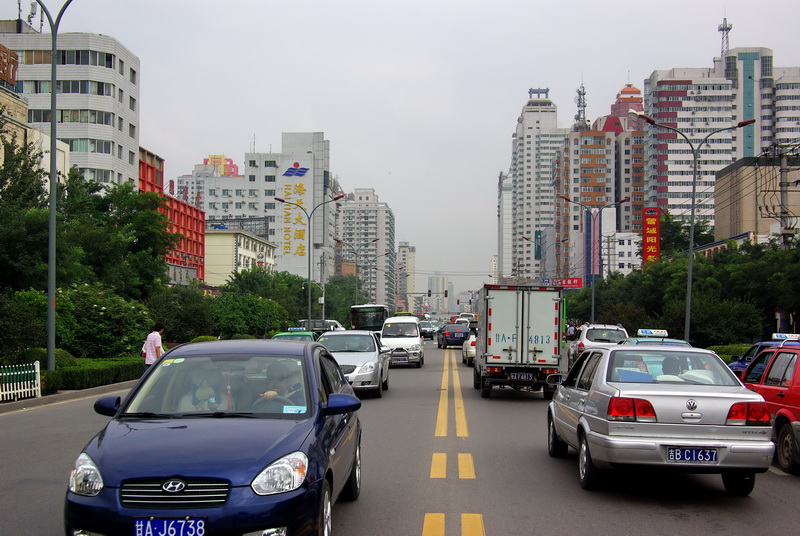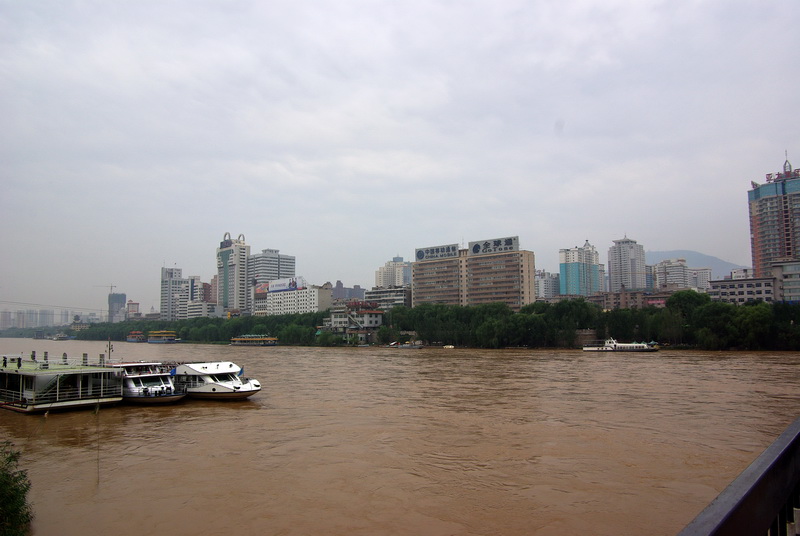In Part 2 of my travel story in Gansu Province, we are now closer to Lanzhou.
 There is more agriculture being practiced in some beautiful countryside. In this, and the following photos, we see both villages and surrounding farm land.
There is more agriculture being practiced in some beautiful countryside. In this, and the following photos, we see both villages and surrounding farm land.
 Local industry here includes some market gardening, using a green house structure of an earthen/brick wall (maybe to conserve heat), with the common plastic covering.
Local industry here includes some market gardening, using a green house structure of an earthen/brick wall (maybe to conserve heat), with the common plastic covering.
 Farming here continues to use much manual labour to cut, wrap and stack the grain (in what we in the West traditionally call “stooks”). This allows for complete ripening of the grain and drying prior to threshing.
Farming here continues to use much manual labour to cut, wrap and stack the grain (in what we in the West traditionally call “stooks”). This allows for complete ripening of the grain and drying prior to threshing.
As is common in other parts of China, much of the planting and harvesting continues to be done on small plots of land. Indeed, the sickle is still commonly used to cut the grain (click to enlarge photo), although from time to time small mechanical harvesters can often be seen in fields.
 After nine hours on the bus from Zhangye, we are back in the capital city of Lanzhou. It is hemmed-in tightly by mountains and stretches for many kilometres along the river valley. And, like so many other Chinese cities, it is developing rapidly with much concrete, glass and steel.
After nine hours on the bus from Zhangye, we are back in the capital city of Lanzhou. It is hemmed-in tightly by mountains and stretches for many kilometres along the river valley. And, like so many other Chinese cities, it is developing rapidly with much concrete, glass and steel.
 Lanzhou is located on one of the two great rivers in China, the Yellow River. And like many names for geographical things in China, the name is highly descriptive!! Yellow is not a bad name for the color of the water here! I’ve learned that the mountains of Gansu provide much of the headwaters for the Yellow River.
Lanzhou is located on one of the two great rivers in China, the Yellow River. And like many names for geographical things in China, the name is highly descriptive!! Yellow is not a bad name for the color of the water here! I’ve learned that the mountains of Gansu provide much of the headwaters for the Yellow River.
 The Gansu Provincial Museum in Lanzhou has a great display of fossils. Of special interest are the mummified remains of non-Han peoples who have lived and died in this region.
The Gansu Provincial Museum in Lanzhou has a great display of fossils. Of special interest are the mummified remains of non-Han peoples who have lived and died in this region.
 Here are just a few photos from the museum display on the Silk Road. The first shows the various historic trade routes throughout China.
Here are just a few photos from the museum display on the Silk Road. The first shows the various historic trade routes throughout China.
 The Gansu portion of the Western trade route overland to the Middle East, Africa and Europe and is often referred to as the Northern Silk Road.
The Gansu portion of the Western trade route overland to the Middle East, Africa and Europe and is often referred to as the Northern Silk Road.
 An Epilogue terminates this section of the museum display. Frequently, Chinese media today often compares the current “open policy” to the times of the ancient Silk Road. Such commentaries tend to emphasize the positive contributions of trade and cultural exchange that enriches both China and the larger world. The Epilogue, here, expresses these same ideas.
An Epilogue terminates this section of the museum display. Frequently, Chinese media today often compares the current “open policy” to the times of the ancient Silk Road. Such commentaries tend to emphasize the positive contributions of trade and cultural exchange that enriches both China and the larger world. The Epilogue, here, expresses these same ideas.
 One of the most fascinating exhibits in the museum, however, is this amazing bronze sculpture of a galloping horse. It was unearthed here in Gansu Province, but its image can now be commonly viewed across China. In Part 1 of this travel log, I have included photos of its replica in Zhangye and the town of Wuwei along the highway. I first remember seeing the image displayed in the famous Huangshan mountain area in Anhui Province.
One of the most fascinating exhibits in the museum, however, is this amazing bronze sculpture of a galloping horse. It was unearthed here in Gansu Province, but its image can now be commonly viewed across China. In Part 1 of this travel log, I have included photos of its replica in Zhangye and the town of Wuwei along the highway. I first remember seeing the image displayed in the famous Huangshan mountain area in Anhui Province.
 And, here it is again, this time on display in front of the Lanzhou Airport.
And, here it is again, this time on display in front of the Lanzhou Airport.
 I conclude my story of my bus travels from Zhangye to Lanzhou with these additional scenic shots taken through the the not-so-clean windows of a moving bus.
I conclude my story of my bus travels from Zhangye to Lanzhou with these additional scenic shots taken through the the not-so-clean windows of a moving bus.
Originally published with Show Story: 2009 10 14
Latest update: 2017 07 07

